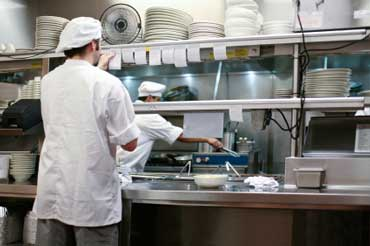TIP 1:
Prep as many steps ahead as you can, so that during service, it requires only a few steps to finish a dish. EXAMPLE: For a menu item such as a cobb salad, all the individual ingredients would be prepped ahead: tomatoes diced, eggs sliced, bacon cooked and diced, blue cheese crumbles and dried cranberries in containers, lettuce washed and cut, chicken breast cooked, chilled and diced, etc.
All that would be necessary to complete your salad would be assembly in a chilled bowl. Upon order, this menu item will take less than a minute to prepare.
TIP 2:
Prepped ingredients should be stored where it is most handy for a line cook to reach them. A refrigerated sandwich prep table that includes a flip top lid, various slots for sixth pans, a cutting board surface (for slicing sandwiches, quesadias and other items on the fly) and a lower storage unit is necessary.
TIP 3:
EVERY PREPPED ITEM SHOULD HAVE IT'S VERY OWN PLACE TO BE STORED!
Why the caps and exclamation point? Yes, I AM yelling at you! Every cook in your kitchen should know the exact location of products (this includes within your walk-ins, canned storage, dry storage, chemical storage, etc). Thus, if a busy line requires anyone from another cook to a chef to step in to help, there is no delay due to hunting for sliced tomatoes, as an example. Busy kitchens can be chaotic enough. CONTROL THE CHAOS.
Tip 4:
Timing of menu items that are on the same order so that they are all completed at relatively the same time is key.
For example, an order that includes a burger with fries, a cobb salad and a Rueben with coleslaw, would be prepared in this fashion.
The burger would be started on the broiler (the meat patty having already been potioned out ahead of time) since this is the item that will take the longest to cook.
The fries would be dropped into the fryer next, since they can cook unattended, and can hold well before the burger they accompany is cooked.
Let's start the rueben: the sliced corned beef goes onto the flat top. Next, we will brush melted butter onto two slices of rye bread, which will then be placed on the flat top to grill. Next, two slices of swiss and a squirt of 1000 island dressing will be added to the bread. A half cup of saurekraut goes on the flat top next. Check your burger!
Next, since the salad can be assembled in about a minute, we'll do that next. Of course, we'll keep in mind that the burger needs to be flipped. So far, two minutes has transpired.
Your fries are ready! Tranfer to a pan equipt with a heat lamp, season with salt.
Check your burger! If done, set to the side. Proceed to set up your plate: bun, (toasted ahead as part of our morning prep), LTO (Lettuce Tomato and Onion) set-up (pre-set by the dozens as part of morning prep) and pickle slices. Add your patty and fries.
Assemble your Rueben, slice and plate with pickles.
Your server will provide the coleslaw for the Rueben and dressing for the cobb.
Your order is complete in around four to six minutes, typical for lunch rush.
I'll add more production tips im my next post.
Happy cooking!


